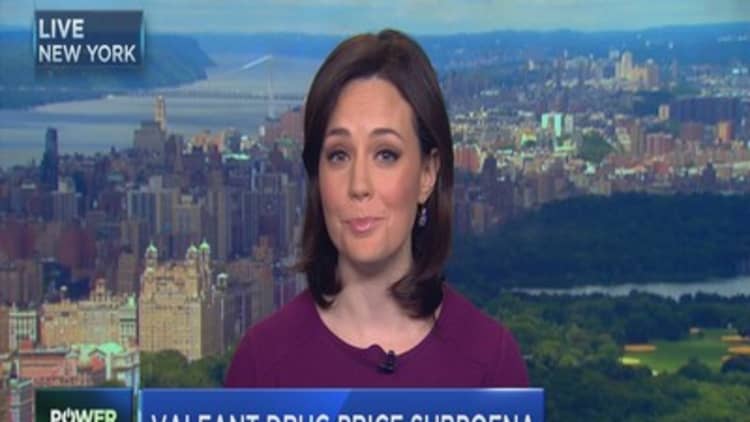
Federal investigations can hang over stocks like the sword of Damocles, slashing company market caps as headlines slowly trickle out.
For Valeant Pharmaceuticals, it's been a deep cut so far — almost 30 percent off its capitalization in one month. So is the bad news now priced into the stock?
For Valeant investors, the bad news is that the bad news seemingly keeps on coming. Just this week, Valeant was subpoenaed by federal prosecutors looking for information on its patient assistance programs, drug pricing and distribution practices. This on top of congressional requests for information on drug pricing.
The spark for all these inquiries: shock-inducing price hikes for two heart drugs. A one-milliliter vial of Isuprel, a treatment for abnormal heart rhythms, jumped to $1,346.62 from $215.46. And a two-milliliter vial of Nitropress, a treatment for high blood pressure and acute heart failure, skyrocketed to $805.61 from $257.80. For its part, Valeant says it is cooperating with the probe.
But for investors, resolution of these investigations — and the clearing of the political haze that's fallen over the pharmaceutical and biotech sector — could be a long and painful process. Investors face a choice: Stick with a fallen winner (even with the sharp declines, Valeant is still up more than 20 percent for the year), or dump it.
Read MoreValeant probed by US prosecutors on drug pricing
So here are a couple worst-case scenarios to consider ahead of Valeant's earnings statement Monday morning:
1. If Valeant has to roll back the price increases for the two heart drugs in question, how would that impact profitability?
BTIG's Tim Chiang, who rates the stock a "buy" with a $250 price target, said the impact of a rollback would not be material. By his back-of-the-envelope estimates, it would be an annualized earnings hit of about 75 cents per share for a company expected to earn north of $11 a share in 2015. That's about a 7 percent haircut to annual earnings.
2. For the other drug price increase candidates in Valeant's portfolio, if there were no change in price, what would the impact be on profitability?
Read MoreHere's the big problem with biotech
Chiang estimates that 10 percent of revenue is derived from older legacy products where historically the concentration of drug price hikes have been. Stripping out price increases (which he estimates are about 40 percent of Valeant's legacy sales) would mean about $800 million of sales in question. Assuming an 85 percent gross margin, Valeant's low 5 percent tax rate and zero marketing expenses on those sales, the earnings impact on an annualized basis would be about $2.
Umer Raffat of Evercore ISI, in a 68-slide presentation, also explored these scenarios. The "money" slide was 49, in which he projected 2016 and 2017 revenue and earnings per share assuming no price increases and assuming Valeant does no acquisitions, which would be counter to its history.
Revenue would grow year over year by 19 percent in 2016 versus consensus of 22.6 percent. Raffat's 2016 EPS is $15.20 versus consensus of 16.28. And for 2017, revenue would increase 7 percent, with implied EPS growth of 16 percent year over year to $17.60.
Those are the numbers.
Then there are other issues to consider, including whether the eye-popping price hikes quoted by media and politicians are really true.
Evercore says they are not, because quoted drug price data often don't take into consideration real-world discounts. Valeant CEO Michael Pearson has tried to explain the confusion over so-called gross versus net pricing, saying "Through managed care contracts ... we are limited. I think the maximum price increase we can take a year is 9 percent ... across dermatology, across ophthalmology, etc." Nine percent is a very different story versus three to tenfold increases.
Read MoreTuring isn't alone in overnight drug price hikes
Fundamental analysis and seeing numbers put to paper can be powerful. The question is whether the numbers can trump the unknown overhang of investigations.
Hopefully investors will get more clarity on both.






